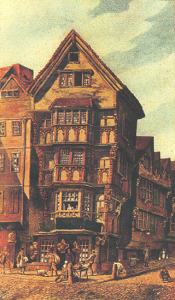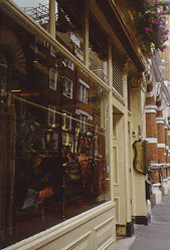Inns and taverns in eighteenth-century London
In the eighteenth century the districts of London teemed with inns and taverns. Thus, in Bishopsgate Street situated at some distance from St. Paul cathedral, the gleaming signs of several inns - “ The White Hart ”, “ The Four Swans ”, “ The Three Nuns ”, “ The Green Dragon ”... - attracted the eyes of the travellers who had almost too great a choice. The reason for such a large number of hostelries in a single street was quite simple: the farmers of the Eastern Counties arrived in London through Bishop’s Gate and quite naturally made their headquarters in Bishopsgate Street, the last stage of their journey.
Fleet Street could boast the greatest number of inns and taverns per square yard in London, some of them of great repute. “ The Cheshire Cheese ” was among the most famous. Samuel Johnson (1709-1784) had his own seat there and the poet John Davidson (1857-1909) wrote a ’ballade’ in its praise a century later:
I know a house of antique ease
Within the smoky city’s pale,
A spot wherein the spirit sees
Old London through a thinner veil.
The modern world so stiff and stale,
You leave behind you when you please,
For long clay pipes and great old ale
And beefsteaks in the “ Cheshire Cheese ”....
“ The Cock ”, another establishment much appreciated by the Londoners in the eighteenth century was still one of the public’s favourite in the following century. The poet and dramatist Alfred Tennyson (1809-1892) often took his meals there in the company of good friends and according to him penned “Will Waterproof’s Lyrical Monologue” in that place:
O plump head-waiter at The Cock,
To which I must resort,
How goes the time? ’Tis five o’clock.
Go fetch a pint of port
“ The Mitre ”, where James Boswell (1740-1795) first had the privilege of dining alone with Samuel Johnson, was also a much frequented tavern.

- The King’s Head Tavern
- [click on the picture to enlarge it]
“ The King’s Head Tavern ”, built in the reign of King Edward VI, was well-known in Fleet Street for the particular layout of its building. The rooms of the tavern were on the first and second floors with shops on the ground floor.
King’s Head Tavern
Fleet Street, London
"From thence, along that tippling street,
Distinguish’d by the name of Fleet,
Where Tavern-Signs hang thicker far,
Than Trophies down at Westminster;
And ev’ry Bacchanalain Landlord
Displays his Ensign, or his Standard,
Bidding Defiance to each Brother,
As if at Wars with one another."Inns and Taverns of Old London
(London: Pitman, 1909) 77-78.
“ The Devil ”, a tavern opposite St. Dunstan Church, owed much of its fame to Ben Jonson (1572-1637) who made it his headquarters. The Apollo room became the meeting place of the club founded by the dramatist. The wits of the capital rubbed shoulders during the merry gatherings at “ The Devil ” and in particular Ben Jonson excelled in repartee and witticisms. It is reported that one evening, the tavern keeper offered to forgive Ben Jonson his reckoning "if he could tell what would please God, please the devil, please the company, and please him. The poet at once replied:
God is pleased, when we depart from sin,
The devil’s pleased, when we persist therein;
Your company’s pleased, when you draw good wine,
and thou’d be pleased, if I would pay thee thine.Henry C. Shelley, Inns and Taverns of Old London (London: Sir Isaac Pitman, 1909) 99]

- Rule’s in Maiden Lane (Covent Garden)
- founded in the late 18th century
[click on the picture to enlarge it]
Many years after Ben Jonson’s death, other great names of the literary world frequented the Apollo room, among them Samuel Pepys(1633-1703), Jonathan Swift (1667-1745) and Richard Steele (1672-1729).
There were also many good inns and welcoming taverns in the streets around Fleet Street: “ The Queen’s Arms ” (St. Paul’s Churchyard) which resounded with the laughter of the famous actor David Garrick (1717-1779) and his friends and with the animated discussions of the learned Doctor Johnson with the members of his club, - “ The Goose and Gridiron ” (St. Paul’s Chuchyard), the “ Mecca ” for concerts and Freemasons’ meetings, - “Dolly’s Chop House” (Queen’s Head Alley) where Daniel Defoe (1660-1731), Jonathan Swift, Alexander Pope (1688-1744) and Henry Fielding (1707-1754) were regular guests, - “The Salutation” (Newgate Street) associated with the names of the three poets and friends Samuel Taylor Coleridge (1772-1834), Charles Lamb (1775-1834) and Robert Southey (1774-1843).
Covent Garden was not only famous for its flower, fruit and vegetable market but also for its friendly taverns like “ The Fleece ”, “ The Rose ”, “ Chatelaine’s ”, “ Macklin’s ” ....
The district of Charing Cross was not lacking in inns and taverns either. “ The Swan ”, “ The Golden Cross ”, “ The Rummer ” were names familiar to the ears of the frequenters of that type of establisment.
So the Londoners of the eighteenth century were not dull creatures and they found great pleasure in meeting friends in the convivial atmosphere of a tavern-or-inn bar either for amusement or a serious discussion.


